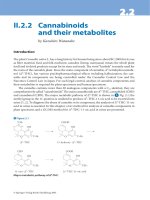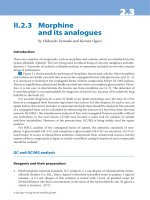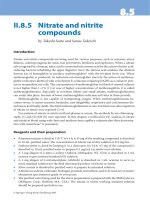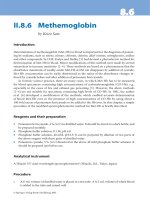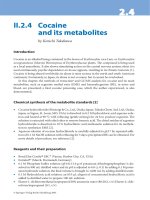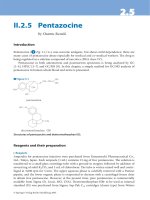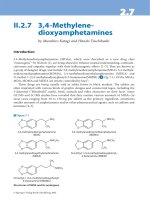Drugs and Poisons in Humans - A Handbook of Practical Analysis (Part 70)
Bạn đang xem bản rút gọn của tài liệu. Xem và tải ngay bản đầy đủ của tài liệu tại đây (181.73 KB, 6 trang )
8.5
© Springer-Verlag Berlin Heidelberg 2005
II.8.5 Nitrate and nitrite
compounds
by Takeshi Saito and Sanae Takeichi
Introduction
Nitrate and nitrite compounds are being used for various purposes, such as coronary artery
dilators, coloring reagents for meat, rust preventives, fertilizers and explosives. When a nitrate
salt is ingested by a human, nitric acid is converted into nitrous acid by the action of nitric acid-
reducing bacteria inhabiting the upper digestive tract; the nitrous acid oxidizes the divalent
ferrous ion of hemoglobin to produce methemoglobin
a
with the trivalent ferric ion. When
methemoglobin is produced, its reduction into hemoglobin starts by the action of methemo-
globin reductase (identical with cytochrome b
5
reductase requiring NADH as a cofactor) pres-
ent in mammalian red cells. e concentration of methemoglobin in blood of normal subjects
is not higher than 1–2 % [1]; in case of higher concentrations of methemoglobin, it is called
methemoglobinemia. Especially in newborn babies and small infants, methemoglobinemia
can easily take place, because of lower methemoglobin reductase activities in these periods.
Methemoglobin is not capable of transporting oxygen. When methemoglobinemia be-
comes severe, it causes cyanosis, headache, easy fatigability, respiratory and conciousness dis-
turbances and nally death. e fatal methemoglobinemia is rare, but fatal ones a er ingestion
of nitrate or nitrite were reported [2–6].
For analysis of nitrate or nitrite in blood plasma or serum, the methods by ion chlomatog-
raphy [7] and GC/MS [8] were reported. In this chapter, a method for GC analysis of nitrate
and nitrite in blood using wide-bore and medium-bore capillary columns a er their derivatiza-
tion with mesitylene
b
is presented.
Reagents and their preparation
• Potassium nitrate is dried at 110 °C for 4 h; 6.35 mg of the resulting compound is dissolved
in 10 mL puri ed water. e concentration of nitrate ion in this solution is 0.4 mg/mL.
• Sodium nitrite is dried by keeping it in a desiccator for 24 h; 4.5 mg of the compound is
dissolved in 10 mL puri ed water to prepare 0.3 mg/mL (as nitrite ion) solution.
• A 1-mg aliquot of 4-nitro-o-xylene (Aldrich, Milwaukee, WI, USA) is dissolved in 1 mL
acetone to give internal standard (IS) solution.
• A 1-mg aliquot of 2-nitromesitylene (Aldrich) is dissolved in 1 mL acetone to serve as
stock standard solution for the nal derivatized product of nitrate or nitrite.
• Silver acetate is dissolved in puri ed water to prepare its saturated solution.
• Anhydrous sodium carbonate, hydrogen peroxide and sulfuric acid to be used are of atomic
absorption spectrometry grade or even purer.
• e puri ed water being used for the above preparations is prepared with the Milli Q device
(Millipore Corp., Bedford, MA, USA). e nitrate or nitrite working standard solution
should be prepared just before use.
650 Nitrate and nitrite compounds
GC conditions
Column: a DB-1 fused silica wide-bore capillary column (15 m × 0.53 mm i.d., lm thickness
0.25 µm, J&W Scienti c, Folsom, CA, USA) and a DB-1 fused silica medium-bore capillary
column (30 m × 0.25 mm i. d., lm thickness 0.25 µm, J&W Scienti c).
GC conditions; instrument: HP5890 Series II and HP6890 Series gas chromatographs
c
(Agilent Technologies, Palo Alto, CA, USA) with nitrogen-phosphorus detectors (NPD); injec-
tion volumes: 1 µL for the HP5890 Series II and 4 µL for the pulsed splitless injection with the
HP6890 Series.
Conditions for the wide-bore capillary column:
Column (oven) temperature
d
: 100 °C → 5 °C/min → 125 °C (2 min); injection temperature:
250 °C; detector temperature: 270 °C; carrier gas: He; ow rate: 30 mL/min.
Conditions for the medium-bore capillary column:
Column (oven) temperature
d
: 110 °C (3 min) → 10 °C/min → 200 °C (3 min); injection
temperature: 280 °C; detector temperature: 280 °C; carrier gas: He; ow rate: 2.1 mL/min.
Procedures
i. Analysis of nitrate
i. A 0.2-mL volume of a test specimen, 20 µL of IS solution and 0.2 mL of the saturated silver
acetate solution
e
are placed in a 1.5-mL volume polypropylene tube with a cap, vortex-
mixed and centrifuged at 3,000 rpm for 5 min.
ii. A 0.2-mL volume of the supernatant solution is transferred to another polypropylene tube
of the same type, and 0.5 mL of concentrated sulfuric acid
f
is added to the solution slowly.
iii. A 0.5-mL volume of mesitylene (Aldrich) is added to the mixture, capped and vortex-
mixed for 2 min.
iv. It is centrifuged at 3,000 rpm for 5 min. A 0.2-mL volume of the resulting upper layer is
transferred to a new 1.5-mL volume polypropylene tube with a cap, followed by the addi-
tion of 20 mg of anhydrous sodium carbonate and vortex-mixed for 1 min.
v. A er centrifugation at 3,000 rpm for 2 min, 1- or 4-µL of the upper layer is injected into
GC.
vi. Various known amounts of nitrate and a xed amount of IS are added to blank specimens
and processed in the same way to construct a calibration curve. e peak area ratio of nitrate
to IS obtained from a test specimen is applied to the calibration curve to calculate its concen-
tration.
ii. Analysis of nitrite
i. A 0.2-mL volume of a test specimen and 0.1 mL of 0.1 M hydrogen peroxide solution are
placed in a 1.5-mL volume polypropylene tube with a cap and vortex-mixed for 3 min.
ii. A er centrifugation, the supernatant solution is decanted into another polypropylene tube
of the same type; 20 µL of IS solution and 0.2 mL of the saturated silver acetate solution
e
are added to the above solution, vortex-mixed and centrifuged at 3,000 rpm for 5 min.
iii. A 0.2-mL volume of the supernatant solution is transferred to a new polypropylene tube of
the same type, followed by addition of 0.5 mL of concentrated sulfuric acid
f
and 0.5 mL of
mesitylene.
651Nitrate and nitrite compounds
iv. e mixture is vortex-mixed for 2 min and centrifuged at 3,000 rpm for 5 min.
v. A 0.2-mL volume of the upper layer is transferred to a new polypropylene tube containing
20 mg anhydrous sodium carbonate and vortex mixed for 1 min.
vi. A er centrifugation at 3,000 rpm for 2 min, 1- or 4-µL of the supernatant solution is in-
jected into GC.
vii. e above procedure consists of the oxidation of nitrite into nitrate and the same extractions
as those for nitrate. A calibration curve for nitrite using blank specimens and IS is also
prepared for quantitation in the same way.
Assessment of the method
> Figure 5.1 shows gas chromatograms using wide-bore and medium-bore capillary columns.
With the medium-bore capillary column, a big and broad peak due to mesitylene appears.
e detection limits are about 0.3 and 0.1 µg/mL for wide-bore and medium-bore capillary
columns, respectively. Since a fatal blood concentration of nitrite was reported to be 0.55 µg/mL
[2], the present method is sensitive enough to detect it with either column.
⊡ Figure 5.1
Detection of nitrite by wide-bore and medium-bore capillary GC after its derivatization into
nitromesitylene. The concentration of nitrite was 5 µg/mL for both chromatograms.
652 Nitrate and nitrite compounds
Except GC-NPD, GC-ECD can be used for analysis of nitrite and nitrate; but the latter
detector may su er from appearance of many interfering peaks. By GC/MS in the EI mode, it
is di cult to detect the derivative, because of its lower sensitivity. Although there is a report [9]
dealing with sensitive GC/MS analysis for nitrate in the NICI mode, it does not seem recom-
mendable in view of the time required for stabilizing the instrument for reproducible ana-
lysis.
Toxic and fatal concentrations
In > Table 5.1, clinical symptoms according to the concentrations of methemoglobin are pre-
sented.
⊡ Table 5.1
Clinical symptoms appearing according to methemoglobin concentrations
Methemoglobin concentration Symptom(s)
not higher than 1–2 % normal
10–15 % cyanosis
not lower than 20 % headache, dyspnea, tachypnea, tachycardia and hypertension
40–50 % mental derangement, listlessness and metabolic acidosis
not lower than 50 % coma, convulsive attack and hypotension
70 % death
A poisoning case [4]
An unidenti ed male was found naked from the waist up in a park at about 10:00 p. m.; he was
su ering from some di culty in breathing. He was sent to a nearby clinic and diagnosed as
exsiccosis; he was brought to a hospital, but he was found dead in the bed of the hospital in the
next morning 7 h a er admission. On the day of his death, autopsy was performed; there are
no notable disorders, but the colors of all organs and blood were chocolate-brown. e blood
methemoglobin concentration was thus measured; it was as high as 78 %. Since the fatal con-
centration of methemoglobin was reported to be about 70 % [1, 2, 5], the cause of his death was
diagnosed as methemoglobinemia. e poison causing his methemoglobinemia was analyzed
by the present method; it was disclosed that he had ingested nitrate. e analytical results for
nitrite and nitrate in his blood and stomach contents are shown in
> Table 5.2. An example
of the gas chromatograms in the present case is also shown in
> Figure 5.2. e blood nitrite
concentration exceeded the fatal level (about 0.5 µg/mL), but nitrite could not be detected
from stomach contents; a high concentration of nitrate is detected from stomach contents.
When a large amount of nitrite is ingested, a victim dies in a short time due to methemoglo-
binemia [2]. When nitrate is ingested, the compound cannot directly convert hemoglobin into
methemoglobin; for such conversion, nitrate should be reduced to nitrite in a human body. In the
present case, the victim had ingested a preparation including a large amount of nitrate, which was
reduced to nitrite by the action of enteric bacteria; the nitrite resulted in accumulation of methe-
moglobin gradually. Similar methemoglobinemia cases had been sometimes observed a er
653Nitrate and nitrite compounds
drinking well water containing high concentrations of nitrate salt [3, 10–12]. However, in the area
where the victim was found, no similar poisoning cases were reported. Except such well water, a
fertilizer product containing nitrate salt can be considered. However, a form or a product con-
taining nitrate ingested could not be speci ed in the present poisoning case.
Notes
a) When nitrite is present in blood, methemoglobin is formed immediately. In severe poison-
ing cases, the concentrations of methemoglobin are more important than those of nitrate
or nitrite. ere is no problem when methemoglobin concentrations can be immediately
measured with a CO oximeter. However, when the analysis has to be made later, it is neces-
sary to store blood specimens at – 80 °C or even lower temperature until analyzed [9].
b)
> Figure 5.3 shows derivatization reaction for nitrate being used in this method; 2-nitro-
mesitylene formed is analyzed by GC. e same reaction method is used for analysis of
nitrite a er its conversion into nitrate. erefore, when nitrate and nitrite coexist in a spec-
imen, the di erence in concentration between a total value a er oxidation and a nitrate
value shows the concentration of nitrite.
c) Any gas chromatograph for a capillary column equipped with a nitrogen-phosphorus
detector can be used, regardless of its manufacturer and type.
Gas chromatogram for nitrite plus nitrate in human blood obtained at autopsy. The blood
specimen was oxidized to convert nitrite into nitrate, which was then derivatized for analysis by
wide-bore capillary GC.
⊡ Figure 5.2
⊡ Table 5.2
Concentrations of nitrite and nitrate in blood and stomach contents obtained at autopsy
Specimen Concentration (µg/mL)
nitrite nitrate
blood 0.76 1.56
stomach contents ND 20.3
ND = not detectable.


